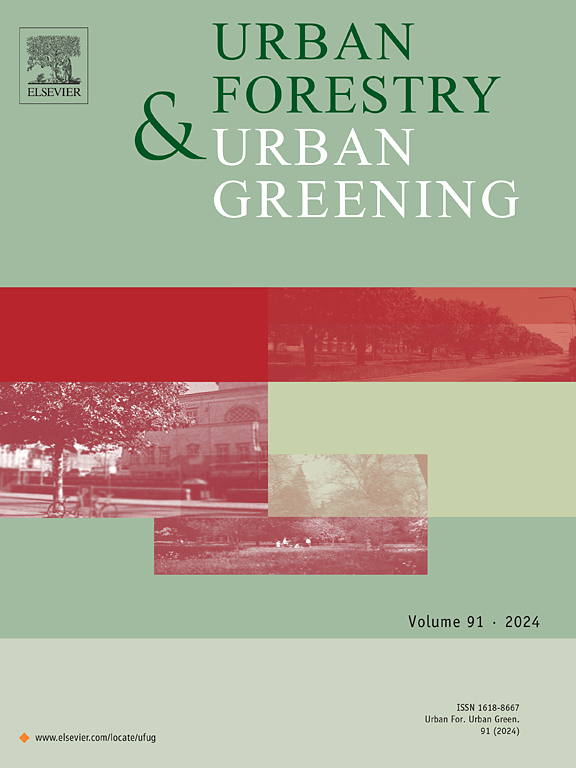The impact of park environmental characteristics and visitor perceptions on visitor emotions from a cross-cultural perspective
IF 6
2区 环境科学与生态学
Q1 ENVIRONMENTAL STUDIES
引用次数: 0
Abstract
Assessing the perception of urban parks and understanding the relationship between environmental characteristics and conflicts in park usage are crucial for the design and management of urban parks. However, quantifying perceptions of parks in large spaces poses challenges, and different regional cultures also exhibit variations in park usage. Therefore, this study aims to explore from a cross-cultural perspective how the environmental characteristics and perceptions of parks affect visitors' emotions. This research collected online comment data from Weibo check-ins in Shanghai and tweets in London between 2022 and 2023. It applied natural language processing (NLP) technology using SnowNLP for sentiment semantic keyword extraction, identifying the sentiment index of each data entry to quantify visitors' sentiments towards urban parks in Shanghai and London. Simultaneously, street view panoramas were obtained for semantic segmentation using the SegNet model and ADE20K to quantify spatial perceptions as independent variables. On this basis, we used nonlinear regression models and MGWR models to explore the relationship between visitors' sentiment values in parks and the park environment. The results showed that walkability in Shanghai was found to more easily bring positive sentiments to visitors, while visitors in London paid more attention to imageability. Walkability, accessibility, and imageability are of the same importance in Shanghai and London, but the correlation and emphasis of visitor perceptions differ, indicating potential conflicts in park usage among different user groups in the two cities' urban parks. Overall, our study offers differentiated planning suggestions that can provide information for urban design decisions, ultimately contributing to the improvement of human well-being.
从跨文化角度看公园环境特征和游客认知对游客情绪的影响
评估人们对城市公园的感知,了解环境特征与公园使用冲突之间的关系,对于城市公园的设计和管理至关重要。然而,对大型空间中的公园感知进行量化是一项挑战,而且不同地区的文化在公园使用方面也表现出差异。因此,本研究旨在从跨文化的角度探讨公园的环境特征和感知如何影响游客的情绪。本研究收集了 2022 年至 2023 年期间上海微博签到和伦敦推文的在线评论数据。研究采用自然语言处理(NLP)技术,使用 SnowNLP 进行情感语义关键词提取,识别每条数据的情感指数,量化游客对上海和伦敦城市公园的情感。同时,利用 SegNet 模型和 ADE20K 获取街景全景图进行语义分割,将空间感知作为自变量进行量化。在此基础上,我们使用非线性回归模型和 MGWR 模型探讨了游客对公园的情感价值与公园环境之间的关系。结果表明,上海的可步行性更容易给游客带来积极情感,而伦敦的游客则更关注可形象性。可步行性、可达性和形象性在上海和伦敦的重要性相同,但游客感知的相关性和侧重点不同,这表明两座城市公园的不同用户群体在公园使用方面可能存在冲突。总之,我们的研究提供了差异化的规划建议,可为城市设计决策提供信息,最终有助于改善人类福祉。
本文章由计算机程序翻译,如有差异,请以英文原文为准。
求助全文
约1分钟内获得全文
求助全文
来源期刊

Urban Forestry & Urban Greening
FORESTRY-
CiteScore
11.70
自引率
12.50%
发文量
289
审稿时长
70 days
期刊介绍:
Urban Forestry and Urban Greening is a refereed, international journal aimed at presenting high-quality research with urban and peri-urban woody and non-woody vegetation and its use, planning, design, establishment and management as its main topics. Urban Forestry and Urban Greening concentrates on all tree-dominated (as joint together in the urban forest) as well as other green resources in and around urban areas, such as woodlands, public and private urban parks and gardens, urban nature areas, street tree and square plantations, botanical gardens and cemeteries.
The journal welcomes basic and applied research papers, as well as review papers and short communications. Contributions should focus on one or more of the following aspects:
-Form and functions of urban forests and other vegetation, including aspects of urban ecology.
-Policy-making, planning and design related to urban forests and other vegetation.
-Selection and establishment of tree resources and other vegetation for urban environments.
-Management of urban forests and other vegetation.
Original contributions of a high academic standard are invited from a wide range of disciplines and fields, including forestry, biology, horticulture, arboriculture, landscape ecology, pathology, soil science, hydrology, landscape architecture, landscape planning, urban planning and design, economics, sociology, environmental psychology, public health, and education.
 求助内容:
求助内容: 应助结果提醒方式:
应助结果提醒方式:


